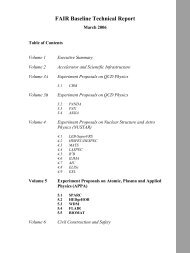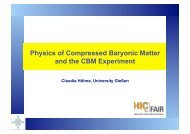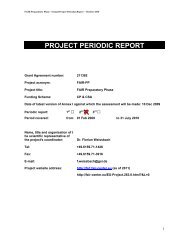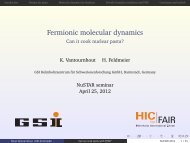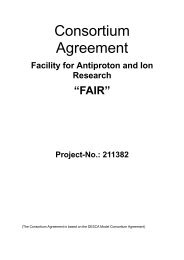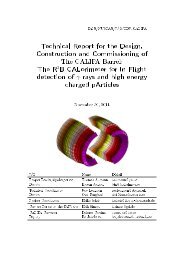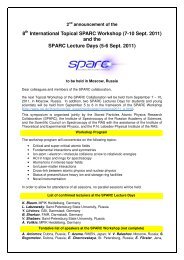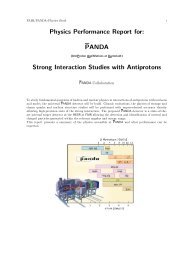NeuLAND - FAIR
NeuLAND - FAIR
NeuLAND - FAIR
You also want an ePaper? Increase the reach of your titles
YUMPU automatically turns print PDFs into web optimized ePapers that Google loves.
2. Physics Scenarios: Requirements for<br />
<strong>NeuLAND</strong><br />
In the following sections we detail the demands for the detection of fast neutrons derived<br />
from the main types of experiments within the broad R 3 B physics program. For a more<br />
detailed description of the overall R 3 B physics programme we refer to the Conceptual<br />
Design Report for <strong>FAIR</strong> [CDR-01] and the R 3 B Technical Proposal [R3B-05] and references<br />
therein. <strong>NeuLAND</strong> will be located downstream from the target. In the full<br />
acceptance mode, the distance from the target is chosen such, that the face-size of the<br />
detector covers the same angular range as the yoke of the dipole magnet R 3 B-GLAD,<br />
namely 80 mrad. For a detector of 2.5×2.5 m 2 face-size the full-acceptance distance is<br />
15.5 m downstream from the target. For some applications, see e.g. section 2.2, the<br />
highest possible resolution is demanded. Here we profit from the length of the R 3 B cave<br />
allowing to position the detector up to 35 m downstream. As a third option <strong>NeuLAND</strong>,<br />
or parts of <strong>NeuLAND</strong>, can be placed closer to the target for the detection of neutrons<br />
stemming from quasi-free scattering interactions, see section 2.4.<br />
2.1. Evolution of the Collective Response of Exotic Nuclei<br />
Electromagnetic excitation of exotic nuclei is a very powerful tool for exploring the evolution<br />
of collective phenomena like giant resonances, especially the giant dipole resonance<br />
(GDR) as a function of neutron-proton asymmetry [Har-01]. At beam energies of up to<br />
1000 AMeV, cross sections for dipole excitations are large, on the order of barn, and the<br />
excitation energies transferred reach up to approximately 20 MeV [Ber-85]. The LAND<br />
collaboration has played a pioneering role in this field discovering the double giant dipole<br />
resonance in stable nuclei [Bor-03], and more recently the pygmy mode in neutron-rich<br />
Sn isotopes [Adr-05]. The appearance of low-lying strength in exotic nuclei [Kli-07],<br />
[Wie-09], is particularly interesting from a nuclear structure point of view since its occurrence<br />
is interpreted as a consequence of neutron-proton asymmetry and the evolution<br />
of skin effects. Similar to the collective giant resonances, this so-called pygmy strength<br />
is related to bulk properties of nuclei and nuclear matter. Various, and partly contradictory,<br />
microscopic theoretical models describe this resonance as discussed in an overview<br />
by N. Paar et al. in Ref. [Paa-07] and references therein. It has been suggested, that the<br />
density dependence of the symmetry energy close to saturation density is correlated with<br />
the low-lying dipole strength in neutron-rich nuclei [Pie-06], very similar to the earlier<br />
reported correlation of the symmetry energy parameters to the neutron-skin thickness in<br />
19





